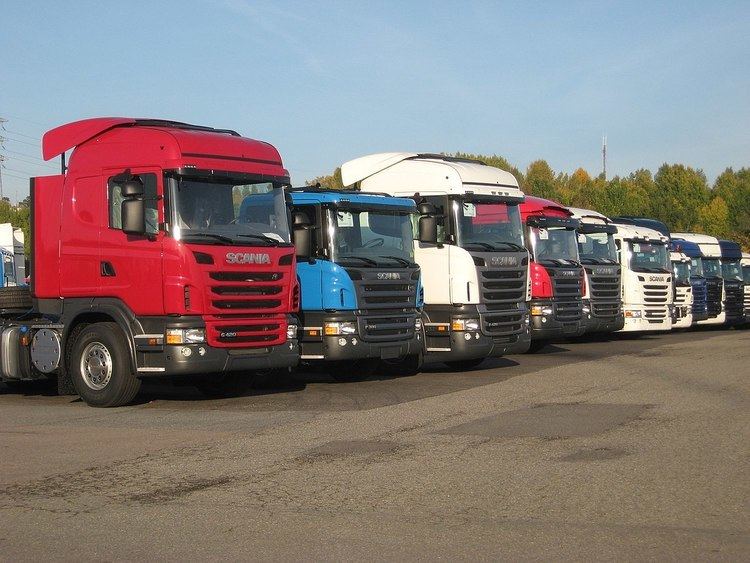Production 2004–present | ||
 | ||
Assembly Sweden: SödertäljeNetherlands: ZwolleFrance: AngersBrazil: São Bernardo do CampoRussia: Saint Petersburg Body style Forward control (P/G/R)Bonneted (T) Engine 8.9 L DC9 I59.3 L DC09 I510.6 L DC11 I611.7 L DC12 I612.7 L DC13 I615.6 L DC16 V816.4 L DC16 V8 | ||
The Scania PRT-range, also referred to as new truck range or Scania's truck range, is the current range of trucks manufactured by the Swedish commercial vehicle manufacturer Scania. It was first introduced as the successor to the 4-series in spring 2004 with the high forward control cab Scania R-series, followed by the low forward control cab Scania P-series and bonneted cab Scania T-series later in the year. The T-series was discontinued in 2005, and in 2007 the medium forward control cab Scania G-series was introduced. The entire range is modular, giving a wide range of different configurations for different types of trucks. The trucks are available with engines ranging from a 9-litre I5 to a 16-litre V8, with the V8 only being available in the R-series (and formerly T-series). A successor to the range was launched in August 2016 with new R-series and flat-floor S-series sleeper cabs.
Contents
First generation (2004–2016)
The range was first launced with the R-series on 31 March 2004, replacing the R94, R114, R124 and R164 of the 4-series. It had 65 percent of the same components as its predecessors, but with a new cab design, new interior and other technical improvements. Full scale production started in Södertälje (Sweden) in April, Zwolle (the Netherlands) in May and in Angers (France) in June. At launch it was available with Euro III engines, but with a 420 hp Euro IV engine available from September. On 20 August, the P- and T-series were launched too, completing the new truck range and replacing the rest of the 4-series models. The new models made their public debut at the IAA commercial vehicle show in Hanover in late September. Production of the 4-series was continued at the Scania Latin America plant in São Bernardo do Campo (Brazil), but was from October 2004 relaunched as the Série Evolução (Evolution Series), featuring the new engines of the PRT-range and the same new model designation, but with the old 4-series cabs.
In October 2005, Scania decided to discontinue the bonneted T-series, having lost its market share over the years. Over the last decade the sales had been halved in Europe and gone down 90 percent in Latin America. In 2004, fewer than 1,000 bonneted Scania trucks were sold worldwide, meaning there was no longer a market for it. In late 2006, Scania launched a new low-entry version of the P-series cab, known as the CP19E, specially intended for garbage trucks, where the driver needs to get in and out quickly. This cab was targeted as a competitor to the Mercedes-Benz Econic.
On 5 September 2007, Scania launched the all-new G-series, with a cab height between the P-series and the R-series. It should not be confused with the old G cab of the 2- and 3-series, which was even lower than the P cab, nor with the G chassis of the 4-series (ie. 94G). On 9 October 2007, the new range was also launched in Latin America, featuring all three P-, G- and R-series from the start. In April 2008, Scania unveiled their first ethanol-powered (ED95) trucks, having manufactured ethanol-powered buses for nearly two decades.
On 17 September 2009, an upgraded R-series was launched with many new features including a sharper exterior styling with larger grille openings, new interior details including the possibility of a factory-installed coffeemaker, new version of the Scania Opticruise gear system with automatic clutch and a driver support system. The G-series received the upgrade shortly afterwards, and the P-series during 2011.
In April 2010, Scania launched a new version of its V8 engine, allowing a maximum output of 730 hp and 3500 N·m in trucks, and preparing for the future Euro VI emission requirements. The new R 730 then became the most powerful large-scale production truck in the world, only to be surpassed by the Volvo FH16 750 (750 hp, 3550 N·m) in September 2011.
Second generation (2016–present)
Since Scania signed a deal with Porsche Engineering in August 2010, a completely new truck cab has been in development. From early 2014, several masked prototypes have been spotted on roads in Sweden, Spain and Norway. The next generation of trucks from Scania was launched at the Grand Palais in Paris on 23 August 2016. The launch included new R-series sleeper cab and the all-new S-series sleeper cab which offers a flat interior floor. Other cab heights, including R-series day cab, of the new generation will have a later launch. The first display of the new generation to a public audience occurred at the Elmia Lastbil fair in Jönköping, Sweden one day later, on 24 August.
Model designation
Scania use different model designations for different contexts. A simplified truck model designation is used for marketing and is visible in the grille. Another complete designation defines the characteristics of the chassis and the drivetrain, and a third designation defines the cab configuration.
Truck model
The simplified truck model name consists of the cab type and power code, divided by a space. Examples: R 730, G 440, P 270.
Complete vehicle
Approximation of the power rating in hp to the nearest ten. The power code has spaces on both sides.
Examples:
Cab
The cab type consists of C and the corresponding letter for the main cab type; CP, CG, CR and CT.
Interior distance between front and rear walls, measured in decimetres.
Examples:
